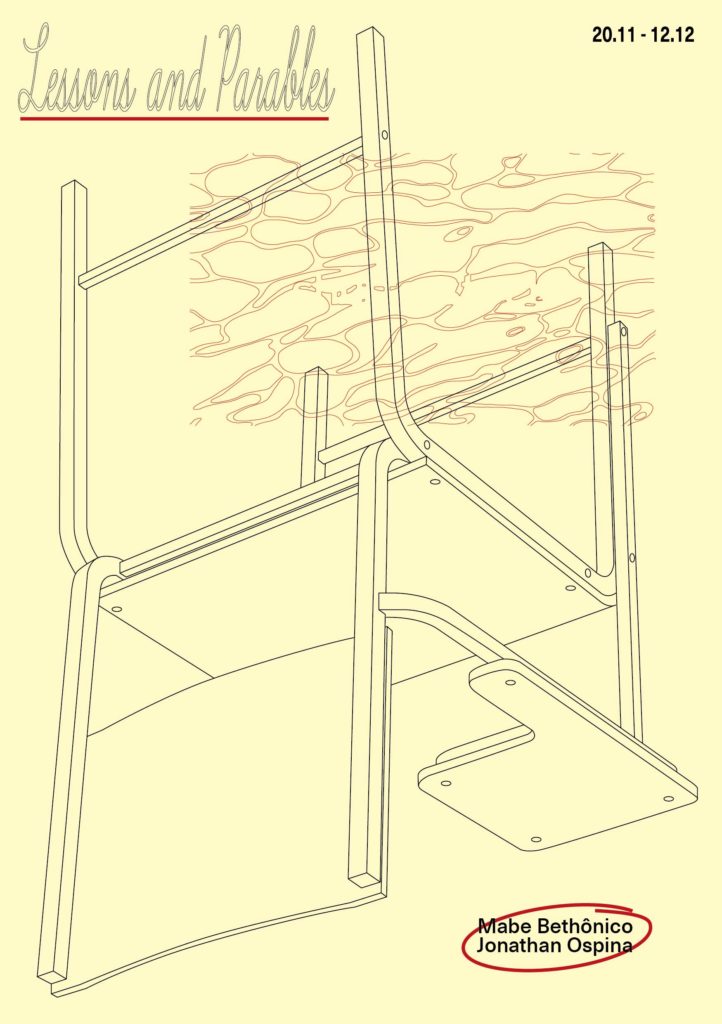Lessons and Parables
Mabe Bethônico and Jonathan Ospina
20 November – 12 December 2021
curated by Dietikon Projektraum
The exhibition Lessons and Parables inhabits the contested spaces of memory by looking at hegemonic narratives of history and the traditions of songs of remembrance.
MABE BETHÔNICO
Mabe Bethônico’s Lessons of Another World departs from pedagogical slides, which were originally used as tools for teaching history in Brazilian public schools during the years of military dictatorship (1964-1988). Their narratives circumvent common colonial violence and their persisting correlations with the dictatorial regime in place. Banalising historical violence was a way to minimise military actions, to perpetuate oppressive power.
The series starts with three color drawings reproducing pedagogical slides, each depicting an illustration with a caption. The captions are translated to English and new captions are proposed, critically observing the originals and revising their content. It is a kind of counter-pedagogy, dismantling given subject matters.


A second part of the project departs from the diapositive that opens the original series. Printed on a flag, the image shows military artefacts and the Brazilian flag to introduce the History of Brazil (1500- 1550). Why the presence of the flag, if it was only introduced in the 19th century? Why the presence of arms as foundational of Brazil? The picture points to the impossibility of power without violence, but did the military regime consider the incorporation of the military drums into the cultural life of the afro descendants? From this last question, a sound piece and a series of blackboards present notes on the Congado, a religious festivity in which military and catholic references are transformed into a ritual of recognition of resisting communities and hommage to their past.



SCHOOL BOOKS USED IN CANTON ZURICH
In addition to Mabe Bethônico’s proposition, we selected school manuals used in Canton Zurich (1970-2010) that depict the history of colonization and decolonization from a swiss-european perspective. We were interested in how these official narratives operate and their consequences in contemporary imaginations and politics. People were invited to write their notes on the pages next to the books.

JONATHAN OSPINA
Jonathan Ospina’s practice is informed by a sensibility for the political implications of sound. Using field recordings and documentation, he tunes in with the narratives of resistance embodied in music. HASTA DONDE VE USTED EL RÍO (UNTIL WHERE DO YOU SEE THE RIVER) traces a musical cartography of the city of Medellín. By focusing on the background music played during street conversations or the moments when these songs interfere with the action, the work plays with everyday listening habits.


Evidencia en ‚La Escombrera’ de Jesus Abad Colorado is a work departing from a photograph taken in 2002 in Medellín by the photojournalist Jesus Abad Colorado. This image became iconic for revealing the political entanglements in the area, especially the submission of the state military to privately organized forces. In working with this material, Jonathan Ospina adds a contemporary resignification to that image as a witness in the armed conflict.

Parable(s) of Memory #1 is a video essay on the musical expressions of Chocó — on the pacific coast of Colombia — and their role in the production of memory and resilience. The region of Chocó has been systematically abandoned and forgotten by the centralist and colonial state of Colombia. In a violent environment — where humans are displaced and dispossessed from their lands by armed groups and rich ecosystems are destroyed by extractive and exploitative practices done by local colons and international multinationals with the blessing of the national government — Jonathan Ospina points to the emancipatory potential of sound archaeologies in the context of an armed conflict.




